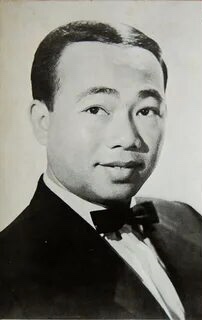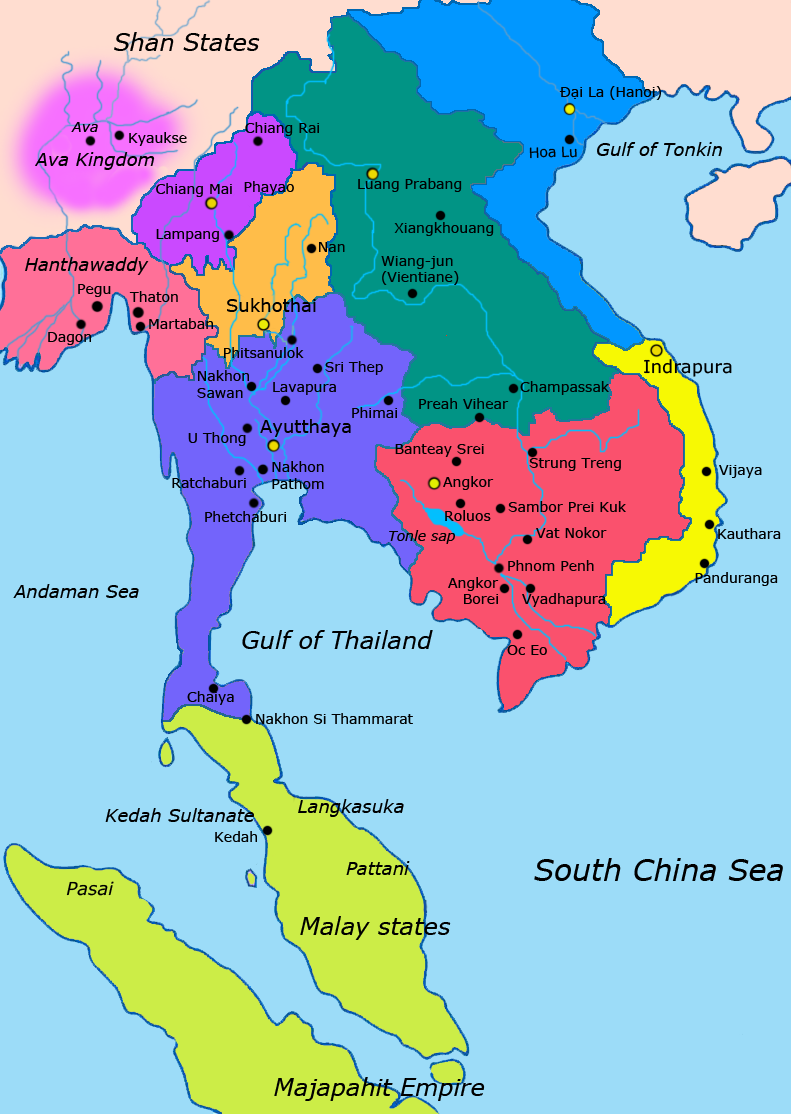|
Cho-kantrum
Kantrum ( th, กันตรึม, km, កន្ដ្រឹម) is a type of folk music played by the Khmer in Isan, Thailand, living near the border with Cambodia. It is a fast, traditional dance music. In its purest form, cho-kantrum, singers, percussion and fiddles dominate the sound. A more modern form using electric instrumentation arose in the mid-1980s. Language Kantrum is interesting from a linguistic perspective. As the Khmer native to Thailand are bilingual, kantrum songs can be sung in Thai ( Isan dialect), Northern Khmer or a combination of the two. In the case of the later, it is most common that a complete verse will be sung in Thai followed by a reciprocating verse in Khmer. However, code switching between the two languages within the same verse also occurs, lending to a wide variety of possibilities for rhyming and tonal euphony. Performers In the late-1980s, Darkie became the genre's biggest star, crossing into mainstream markets in the later 1990s. ... [...More Info...] [...Related Items...] OR: [Wikipedia] [Google] [Baidu] |
Cho-kantrum
Kantrum ( th, กันตรึม, km, កន្ដ្រឹម) is a type of folk music played by the Khmer in Isan, Thailand, living near the border with Cambodia. It is a fast, traditional dance music. In its purest form, cho-kantrum, singers, percussion and fiddles dominate the sound. A more modern form using electric instrumentation arose in the mid-1980s. Language Kantrum is interesting from a linguistic perspective. As the Khmer native to Thailand are bilingual, kantrum songs can be sung in Thai ( Isan dialect), Northern Khmer or a combination of the two. In the case of the later, it is most common that a complete verse will be sung in Thai followed by a reciprocating verse in Khmer. However, code switching between the two languages within the same verse also occurs, lending to a wide variety of possibilities for rhyming and tonal euphony. Performers In the late-1980s, Darkie became the genre's biggest star, crossing into mainstream markets in the later 1990s. ... [...More Info...] [...Related Items...] OR: [Wikipedia] [Google] [Baidu] |
Music Of Thailand
The music of Thailand reflects its geographic position at the intersection of China and India, and reflects trade routes that have historically included Africa, Greece and Rome. Traditional Thai musical instruments are varied and reflect ancient influence from far afield - including the ''klong thap'' and ''khim'' (Persian origin), the ''jakhe'' (Indian origin), the ''klong jin'' (Chinese origin), and the '' klong kaek'' (Indonesian origin). Though Thailand was never colonized by colonial powers, pop music and other forms of modern Asian, European and American music have become extremely influential. The two most popular styles of traditional Thai music are luk thung and mor lam; the latter in particular has close affinities with the music of Laos. Aside from the Thai, ethnic minorities such as the Lao, Lawa, Hmong, Akha, Khmer, Lisu, Karen and Lahu peoples have retained traditional musical forms. Traditional and folk music Classical music Thai classical music is syn ... [...More Info...] [...Related Items...] OR: [Wikipedia] [Google] [Baidu] |
Folk Music
Folk music is a music genre that includes traditional folk music and the contemporary genre that evolved from the former during the 20th-century folk revival. Some types of folk music may be called world music. Traditional folk music has been defined in several ways: as music transmitted orally, music with unknown composers, music that is played on traditional instruments, music about cultural or national identity, music that changes between generations (folk process), music associated with a people's folklore, or music performed by custom over a long period of time. It has been contrasted with commercial and classical styles. The term originated in the 19th century, but folk music extends beyond that. Starting in the mid-20th century, a new form of popular folk music evolved from traditional folk music. This process and period is called the (second) folk revival and reached a zenith in the 1960s. This form of music is sometimes called contemporary folk music or folk rev ... [...More Info...] [...Related Items...] OR: [Wikipedia] [Google] [Baidu] |
Code-switching
In linguistics, code-switching or language alternation occurs when a speaker alternates between two or more languages, or language varieties, in the context of a single conversation or situation. Code-switching is different from plurilingualism in that plurilingualism refers to the ability of an individual to use multiple languages, while code-switching is the act of using multiple languages together. Multilingualism, Multilinguals (speakers of more than one language) sometimes use elements of multiple languages when conversing with each other. Thus, code-switching is the use of more than one linguistic variety in a manner consistent with the syntax and phonology of each variety. Code-switching may happen between Sentence (linguistics), sentences, sentence fragments, words, or Morpheme, individual morphemes (in synthetic languages). However, some linguists consider the Loanword, borrowing of words or morphemes from another language to be different from other types of code-switchin ... [...More Info...] [...Related Items...] OR: [Wikipedia] [Google] [Baidu] |
Cambodian Music
The music of Cambodia is derived from a mesh of cultural traditions dating back to the ancient Khmer Empire, India, China and the original indigenous tribes living in the area before the arrival of Indian and Chinese travelers. With the rapid Westernization of popular music, Cambodian music has incorporated elements from music around the world through globalization. Folk and classical music Cambodian Art music is highly influenced by ancient forms as well as Hindu forms. Religious dancing, many of which depict stories and ancient myths, are common in Cambodian culture. Classical Khmer music usually is divided into three parts: ''pin peat, phleng kar,'' and ''mahori,'' all of which are associated with their religious dances. Some dances are accompanied by a pinpeat orchestra, which includes a ching (cymbal), roneat (bamboo xylophone), pai au (flute), sralai (oboe), chapey (bass moon lute or banjo), gong (bronze gong), tro ( fiddle), and various kinds of drums. Each moveme ... [...More Info...] [...Related Items...] OR: [Wikipedia] [Google] [Baidu] |
Music Of Cambodia
The music of Cambodia is derived from a mesh of cultural traditions dating back to the ancient Khmer Empire, India, China and the original indigenous tribes living in the area before the arrival of Indian and Chinese travelers. With the rapid Westernization of popular music, Cambodian music has incorporated elements from music around the world through globalization. Folk and classical music Cambodian Art music is highly influenced by ancient forms as well as Hindu forms. Religious dancing, many of which depict stories and ancient myths, are common in Cambodian culture. Classical Khmer music usually is divided into three parts: ''pin peat, phleng kar,'' and ''mahori,'' all of which are associated with their religious dances. Some dances are accompanied by a pinpeat orchestra, which includes a ching (cymbal), roneat (bamboo xylophone), pai au (flute), sralai (oboe), chapey (bass moon lute or banjo), gong (bronze gong), tro (fiddle), and various kinds of drums. Each movement ... [...More Info...] [...Related Items...] OR: [Wikipedia] [Google] [Baidu] |
Chrieng Brunh
Chrieng Brunh ( Northern Khmer: เจรียงเบริญ ) is a type of Khmer vocal music or epic recitative practiced by the Khmers indigenous to Northeast Thailand. From the Khmer words ''charieng'', meaning "song" and ''brunh'' referring to the particular rhythm, it is also sometimes transliterated as ''jarieng be-rin'' or similar variations. ''Chrieng brunh'' may be sung by an individual or as a duet by a man and a woman singing alternating verses. Although this type of folk music can be performed a cappella, it is often accompanied by the khaen. Ethnic Thai's sometime make comparisons to the Lao mor lam, but linguist Christian Bauer has written that ''chrieng brunh'' is not an adaptation of other kinds of music in Northeast Thailand but is a traditional form of Khmer music.Bauer, Christian. 1989. "Khmer epic recitatives inherited forms or adaptation?" ''Journal of Language and Culture'' 8.1:60–89.Bauer, Christian. 1990. "Khmer epic recitatives inherited forms o ... [...More Info...] [...Related Items...] OR: [Wikipedia] [Google] [Baidu] |
Morlam
Mor lam ( Lao: ໝໍລຳ; Thai/Isan: หมอลำ ; ) is a traditional Lao form of song in Laos and Isan. ''Mor lam'' means 'expert song', or 'expert singer', referring to the music or artist respectively. Other romanisations used include mor lum, maw lam, maw lum, moh lam, mhor lum, and molum. In Laos, the music is known simply as lam (ລຳ); mor lam (ໝໍລຳ) refers to the singer. The characteristic feature of ''lam'' singing is the use of a flexible melody tailored to the tones of the words in the text. Traditionally, the tune was developed by the singer as an interpretation of a '' klon'' poem and accompanied primarily by the ''khene'' (a free reed mouth organ). The modern form is frequently composed and uses electrified instruments. Traditional forms (and some Lao genres) use a slower tempo than the quicker tempo and faster deliveries of more modern lam music. Strong rhythmic accompaniments, vocal leaps, and a conversational style of singing distinguish '' ... [...More Info...] [...Related Items...] OR: [Wikipedia] [Google] [Baidu] |
Chalermpol Malakham
Chalermpol Malakham (also written Malakam, th, เฉลิมพล มาลาคำ) (b. 10 October 1962 in Surin Province — ), is a singer from the Isan area of Thailand. Known mostly for the Luk Thung and Mor lam styles, he is also considered a talented performer of Kantrum. Although the majority of Chalermpol's songs are in Thai, he often sings in Northern Khmer as well. Early life and career He was born on 10 October 1962, in Surin Province. He finished education in Primary 4, and started on stage in a singing contest presented by Radio Thailand of Surin Province. He recorded his first album "Sa Uen Uai Porn", but he was made popular in 1990 by song titled "Tam Jai Mae Terd Nong", because Mor lam is very popular at national level as well as in foreign countries to date. After becoming popular, he moved to Ubon Ratchathani Province. In 2011 Thai general election, he registered as a member of House of Representatives of Thailand from Chartthaipattana Party, but ... [...More Info...] [...Related Items...] OR: [Wikipedia] [Google] [Baidu] |
Darkie (musician) , formerly Darkie, a brand of toothpaste
{{disambig, surname, given name ...
Darkey, Darkie or Darky may refer to: * Darkey, disparaging term for a black person *Darkey Kelly (d. 1761), Irish woman burned at the stake * Joe Darkey (born 1942), former Ghanaian professional boxer who competed in the 1960s *David Bedell-Sivright (1880–1915), Scottish international rugby union player nickname Darkie *Darlie Darlie (originally known as Darkie) is an oral care brand owned and manufactured by the Hawley & Hazel Company with focus on Chinese and Southeast Asian markets. The company is headquartered in Hong Kong with manufacturing facilities in Zhongsh ... [...More Info...] [...Related Items...] OR: [Wikipedia] [Google] [Baidu] |
Northern Khmer Dialect
Northern Khmer (; km, ខ្មែរខាងជើង), also called Surin Khmer ( km, ខ្មែរសុរិន្ទ, link=no), is the dialect of the Khmer language spoken by approximately 1.4 million Khmers native to the Thai provinces of Surin, Sisaket, Buriram and Roi Et as well as those that have migrated from this region into Cambodia.Thomas, David & Wanna, Tienmee; 1984; ''An Acoustic Study of Northern Khmer Vowels''; Mon-Khmer Studies, vol 16–17 Northern Khmer differs from the standard language, based on a dialect of Central Khmer, in the number and variety of vowel phonemes, consonantal distribution, lexicon, grammar, and, most notably, pronunciation of syllable-final , giving Northern Khmer a distinct accent easily recognizable by speakers of other dialects. Some speakers of Northern Khmer may understand other varieties of Khmer but speakers of standard Khmer who have not been exposed to Northern Khmer often have trouble understanding Northern Khmer at firs ... [...More Info...] [...Related Items...] OR: [Wikipedia] [Google] [Baidu] |





